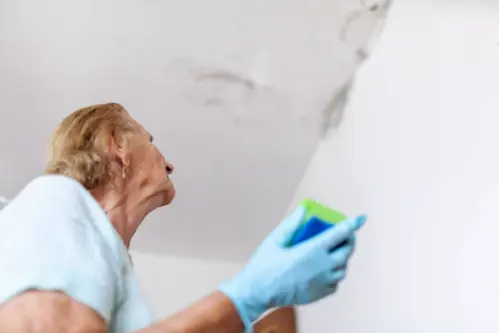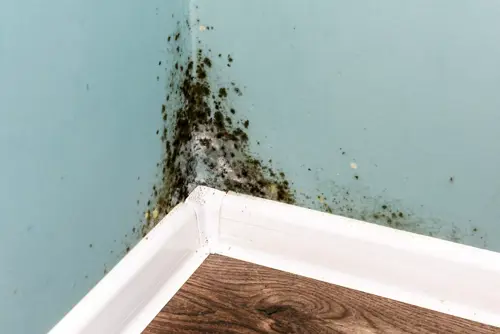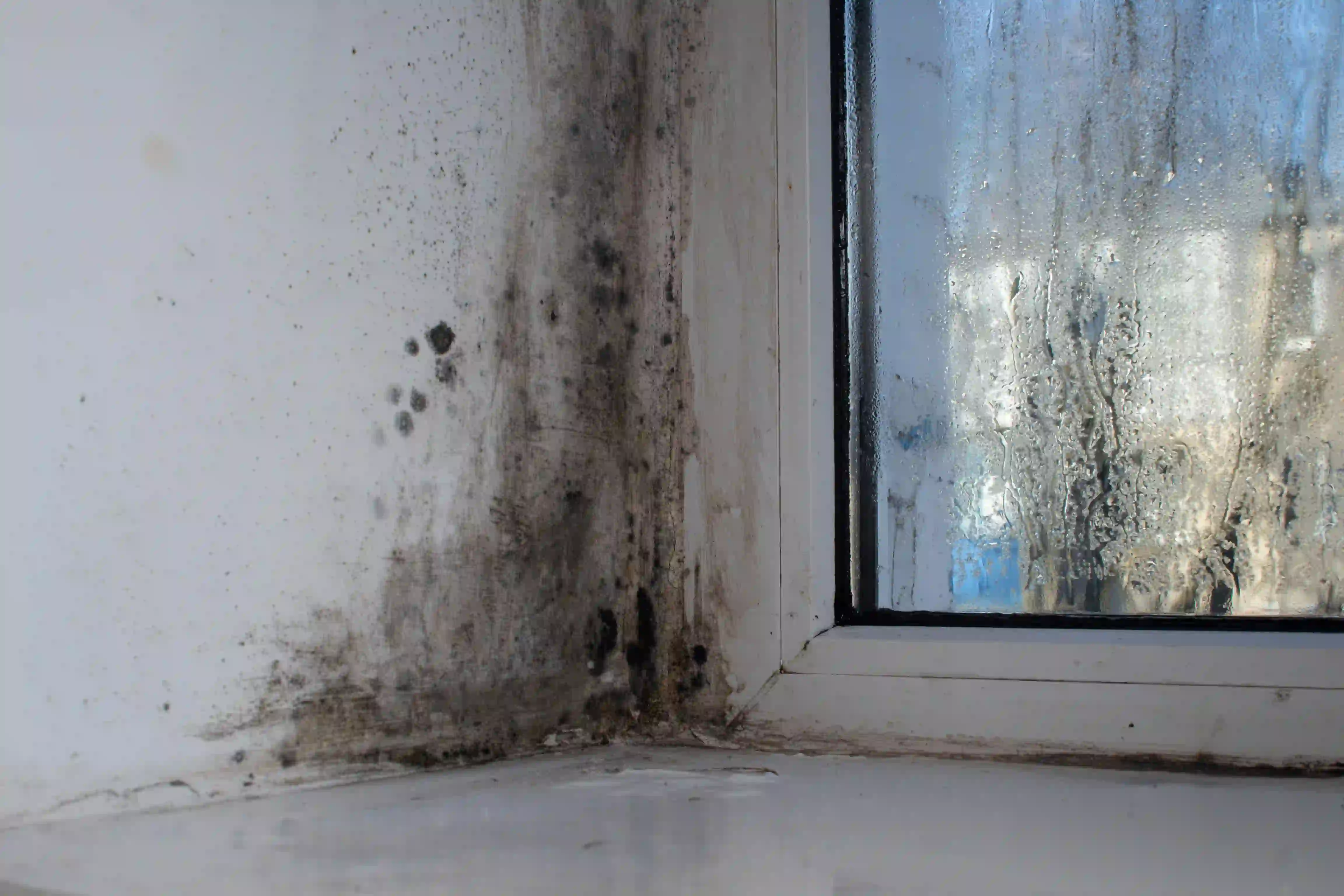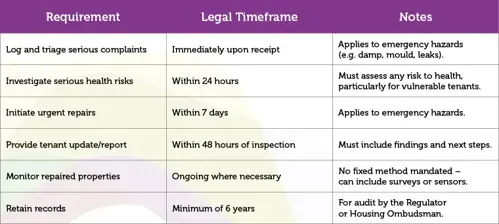The introduction of the Social Housing (Regulation) Act 2023, marked significant reform in social housing, to bring positive change for residents and ensuring that they live in safe, good quality homes that are free from hazards that can cause a risk to health.
The new legislation, widely known as Awaab’s Law, has a phased approach from 2025 – 2027. In this guide, we explore what the changes are for housing associations and other social housing providers, helping you to make the necessary strategic and practical changes to remain compliant with the regulations and take advantage of this opportunity to put in place operational systems that better protect residents.
Jump to:
● What are the consequences of non-compliance with Awaab’s Law?
● What are the Awaab’s Law timescales for different phases?
● How social landlords can prepare for Awaab’s Law
● How to remain compliant (Free Awaab’s Law Checklist)
● Awaab’s Law FAQs for Housing Associations
What is Awaab’s Law?
Awaab’s Law is new legislation designed to protect social housing tenants from dangerous living conditions. It was introduced following the tragic death of two-year-old Awaab Ishak in Rochdale in 2020, whose cause of death was directly linked to prolonged exposure to mould in his family’s housing association flat.
Awaab’s Law places new requirements on social housing providers to respond quickly and effectively to reports of hazards such as damp and mould in tenants’ homes.
While social landlords have long had to fulfil some requirements when health and safety hazards are reported, Awaab’s Law gives mandatory timeframes in which the issues need to be identified and resolved and demands that the process is clear and transparent.
The initial phase of Awaab’s Law means that social landlords will need to investigate health risks in their properties within a fixed timeframe of the report being made. If urgent repairs are identified, these need to be carried out within a set period of time. Affected residents also need to be kept updated on findings and the next steps after the inspection.
When does Awaab’s Law come into effect?
There are three different phases to Awaab’s Law, with various elements of the legislation rolling out from October 2025 through to 2027. This is to give social housing providers time to prepare fully for the new requirements and help ensure that there are appropriate systems in place so they can remain compliant.
The first phase of Awaab’s Law comes into force from 27th October 2025, with the remaining phase dates to be confirmed later.
What is the legal framework behind Awaab’s Law?
The journey for Awaab’s Law began in November 2022, when the coroner’s report into the death of two-year-old Awaab Ishak found that the boy’s death was directly related to the damp and mould in his social housing home.
As a result of this case and the clear need for change, amendments were made to Section 42 of the Social Housing (Regulation) Act 2023.
In February 2025, it was confirmed by the UK government that Awaab’s Law was to be phased in from October 2025 onwards. Social landlords have a duty to prepare for the initial rollout and ensure their systems are ready for full compliance by 2027.
What are the consequences of non-compliance with Awaab’s Law?

If social housing providers are found not to be complying with Awaab’s Law, this brings significant risks, such as:
● Regulatory action: The Regulator of Social Housing (RSH) can issue enforcement notices, require performance improvements, and in serious cases, impose unlimited fines on non-compliant housing associations and other social housing providers.
● Legal liability: Tenants may pursue legal claims if landlords fail to meet their obligations under the new law.
● Reputational damage: Media and public scrutiny of housing standards has increased significantly, meaning failures can quickly escalate into high-profile scandals.
● Tenant health and safety risks: Beyond legal and financial consequences, non-compliance risks severe harm to tenants, particularly children and vulnerable adults.
What are the Awaab’s Law timescales for different phases?
Phase 1: From October 2025
Effective from 27th October 2025 onwards, social landlords need to address emergency hazards and damp and mould that pose a significant risk of harm to residents within a fixed timeframe.
This means that:
● Serious complaints about damp and mould or emergency hazards made by residents need to be logged and triaged immediately, as soon as they are reported.
● Serious emergency health risks must be investigated within 24-hours, with photo evidence taken, along with inspection notes.
● Other potential hazards, such as damp and mould, must be investigated within 10 working days.
● The resident’s health, vulnerabilities and circumstances need to be factored into the investigation and action plan.
● Urgent repairs to emergency hazards need to be made within 7 days.
● Residents need to be updated on what is happening within 3 days of the inspection.
● Repaired properties need to be monitored to ensure that the problem has been resolved.
● Records of the entire process need to be retained for at least 6 years by the social housing provider.
Phase 2: From 2026
In 2026, the requirements and investigation/repairs timescales will expand to cover a wider range of hazards, beyond emergency hazards and damp and mould, to cover more risks and hazards including:
● Excess cold or excess heat
● Structural collapse
● Fire or electrical hazards
● Falls associated with fixed parts of the home, such as baths
● Falls on level surfaces, between levels or on stairs/steps
● Explosions
● Domestic and personal hygiene, sanitation and drainage
● Food safety.
Phase 3: From 2027
In 2027, the regulations will be extended to all other Housing Health and Safety Rating System (HHSRS) hazards (apart from overcrowding) in social housing properties where there is deemed a significant risk of harm.
These hazards include all those mentioned previously, plus:
● Asbestos (and manufactured mineral fibres)
● Biocides, Volatile Organic Compounds (VOCs) and other chemical hazards
● Carbon Monoxide (CO) and fuel combustion products
● Lead
● Radiation
● Un-combusted fuel gas
● Poor security against entry by intruders
● Inadequate lighting
● Noise
● Water supply
● Flames and hot surfaces
● Physical injuries from architectural features e.g. low headroom or the position and operability or amenities.
How social landlords can prepare for Awaab’s Law

By October 2025, landlords should prepare to have systems in place that are capable of:
● Tracking tenant complaints and reports in real time, ensuring urgent cases are prioritised.
● Automatically triggering inspections and repair orders within the legal timescales.
● Maintaining accurate, auditable records of complaints, investigations, actions taken, and tenant communications, stored securely for at least 6 years.
● Generating compliance reports for internal monitoring and external regulators.
● Integrating with asset management systems, so that recurring problems (such as mould in a particular building or type of home) can be tracked and proactively addressed.
Ensuring that staff are trained fully on these systems is essential
How to remain compliant (Free Awaab’s Law Checklist)
We’ve developed an Awaab’s Law Checklist to help ensure that housing associations and other social housing providers can be ready and compliant.
Review and update current policies and procedures
✔ Ensure that your current/new workflows include protocols for triaging hazards, triggering investigations and repairs, all in line with the new timelines.
✔ Establish reporting procedures that align with guidance for resident communications and contractor reports.
✔ Put a plan in place for temporary rehousing of residents if repairs cannot be made within the new timescales.
✔ Ensure that your IT systems and software solutions are able to manage the new workflows, triggers, reports and notifications.
Proactively manage properties
✔ Identify high-risk properties and put in place a monitoring schedule.
✔ Identify and prioritise properties with vulnerable residents (e.g. elderly, young children, those with known disabilities etc).
✔ Carry out proactive inspections to help spot any issues early.
✔ Schedule preventative repairs whenever possible.
Prioritise team training
✔ Ensure your property teams and contractors are appropriately trained on the new legal responsibilities, assessing hazards, evaluating vulnerable residents, the documentation needed for compliance and routes for escalation when urgent issues are discovered.
✔ Ensure that staff are able to handle complex cases and can identify when specialist input is needed.
✔ Ensure that customer service teams are fully aware of the new requirements for communication of reports and next steps to residents.
Review contractor agreements
✔ Check that your existing contracts are compliant with Awaab’s Law timescales and the reporting requirements.
✔ Build a network of backup contractors in the event of capacity challenges.
✔ Consider using a framework to simplify damp and mould procurement.
Look at resource planning
✔ Ensure that you’re kept informed about your capacity for carrying out inspections, repairs and arranging alternative accommodation when needed.
✔ Assess staffing levels vs demand, especially for urgent callouts on weekends and bank holidays.
Review communication strategies
✔ Inform residents about the changes to the law and how it affects them and their rights, using a variety of formats to reach as many people as possible.
✔ Ensure that internal workflows that involve multiple steps are ‘joined up’ with open communication between teams so that the requirements can be met.
✔ Establish protocols for acknowledging reports, along with informing residents about findings and next steps.
Establish compliant reporting and governance systems
You will need systems in place to:
✔ Log all reports, investigations, repair works and communications
✔ Report performance vs Awaab’s Law requirements to leadership, tenants and boards
✔ Maintain auditable records for regulatory scrutiny
✔ Ensure evidence of compliance is available
✔ Provide governing bodies with your plan for preparedness and progress against it
Awaab’s Law FAQs for Housing Associations
Is there a ready-made solution for damp and mould that housing associations can use to help comply with Awaab’s Law?
For social housing providers who need to make immediate and effective management on damp and mould in residential properties, a damp and mould procurement framework can help to streamline the solution to this challenge. This works by enabling social housing providers to access pre-approved qualified contractors nationwide who specialise in damp and mould, whether for inspections and surveys or the remedial work itself.
This can help any housing associations by providing a reliable, efficient and compliant path for managing and repairing damp and mould issues in their properties.
Does Awaab’s Law apply to private landlords?
As things stand currently, Awaab’s Law only applies to social housing providers, but is expected to be rolled out to the private rented sector too as part of the Renters’ Rights Bill in the future. There are currently no details or potential dates for how Awaab’s Law will be applied to privately rented properties.
What damp and mould support should housing associations provide to their residents?
Housing associations and other social housing providers should provide a combination of practical and advisory support to residents in relation to damp and mould. Any complaints of damp and mould will need to be investigated and remedial work carried out if necessary – all in line with Awaab’s Law timescales.
In addition to this, social housing providers should be offering residents clear, practical advice about how to reduce moisture levels in their home and prevent damp and mould resulting from condensation


